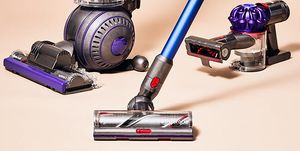A version of this story appears in Gear Patrol Magazine. Subscribe today.
In 1997, Electrolux introduced the Trilobite, the first automatic vacuum cleaner, to the world. Featured on BBC’s Tomorrow’s World TV show, the Trilobite gave the public a reason to believe that they would one day own a piece of real-world sci-fi tech that would clean up all of their floor messes.
Two decades later, robot vacuums, or “robovacs,” as they’re affectionately called, are now a $3.5 billion market, with models ranging from $100 to nearly a grand. But no matter how advanced or intuitive these robovacs get, you’ll never find one in my home — and it’s not because I’m afraid of a full-scale robot invasion.
Here’s why most people should stick to manual vacuuming.
Do Roombas work on carpet? Not really
Robovacs excel at cleaning hard floors. Don’t expect one to do very well at vacuuming your rugs and carpets, though. It’ll do perfectly fine at suctioning up the debris on the surface level of your carpet. But the higher the pile and the longer the fibers, the more dirt and debris that gets stuck toward the base. Robovacs have neither the suction power nor bristle length to get deep down into rugs or carpets, making their cleanings purely superficial.
Roombas get stuck
Despite being designed to avoid furniture and walls, robot vacuums have a tendency to get stuck. And sometimes they get stuck in the most frustrating ways that make prying them from their trap even more annoying. They’ll manage to navigate in between chair legs before realizing those chair legs are now the bars to their jail cell. Step away for too long and you’ll find your robovac has spent more time locked away than cleaning your floors.
Robovacs require your house to be clean already
Robovacs need a perfectly clutter-free home to properly run. They probably won’t register that there are some charging cables on the floor, so they’ll run them over and get stuck. Before you even start your robovac, the onus is on you to remove everything from the floor to create an obstacle-free workspace, which defeats the purpose of having an automatic vacuum. And even if your floors are completely bare (which can be nearly impossible), many robovacs can’t transition properly from hardwood floors to carpets.
Robot vacuums and pet poop are a nightmare waiting to happen
Your robot vacuum is supposed to avoid crashing into things, whether it’s a wall, your foot or a pile of clothes on the floor. But that turd your dog just dropped? Yeah, it’s getting mowed down … and around … and all over the place. Head to YouTube, and you’ll find too many videos of robovacs painting homes with feces. The issue is so prevalent that iRobot, maker of the popular Roomba robot vacuums, recently released a model that’s designed specifically to identify and maneuver around your pet’s business.
Robot vacuums take a long time.
Without a doubt, you can manually vacuum a space faster than a robot vacuum can. That’s because a robot vacuum needs to run through its algorithms to decide where to go and how to get there — and that’s not including the minutes lost when the thing gets stuck somewhere. Plus, all that time spent trying to figure out where to go leads to faster battery drain.
The Alternative? Manual Vacuuming
A manual vacuum can do you much better if you follow a few basic ground rules. These quick tips will help you tackle the chore with, ahem, robot-like efficiency.
Follow a grid: When you vacuum, imagine there’s a grid on your floor and stick to it. This will ensure you cover every square inch of your home so your floors get extra clean.
Clean your vacuum: Your vacuum is doing some heavy cleaning, so the least you can do is clean it. Take out the brush and give it a thorough, soapy soak every once in a while lest you start spreading dirt everywhere.
Use your attachments: Besides the main cleaning head, a traditional vacuum will come with myriad attachments for cleaning high-up areas like ceilings, fans and vents, or suctioning upholstery. Use them.
Go from high to low: Ceilings and fans don't need as much love as your floors, but when you do decide to clean those elevated areas, hit them first. Some dust will fall to the floor, which you can then suck up on your bottom pass.























